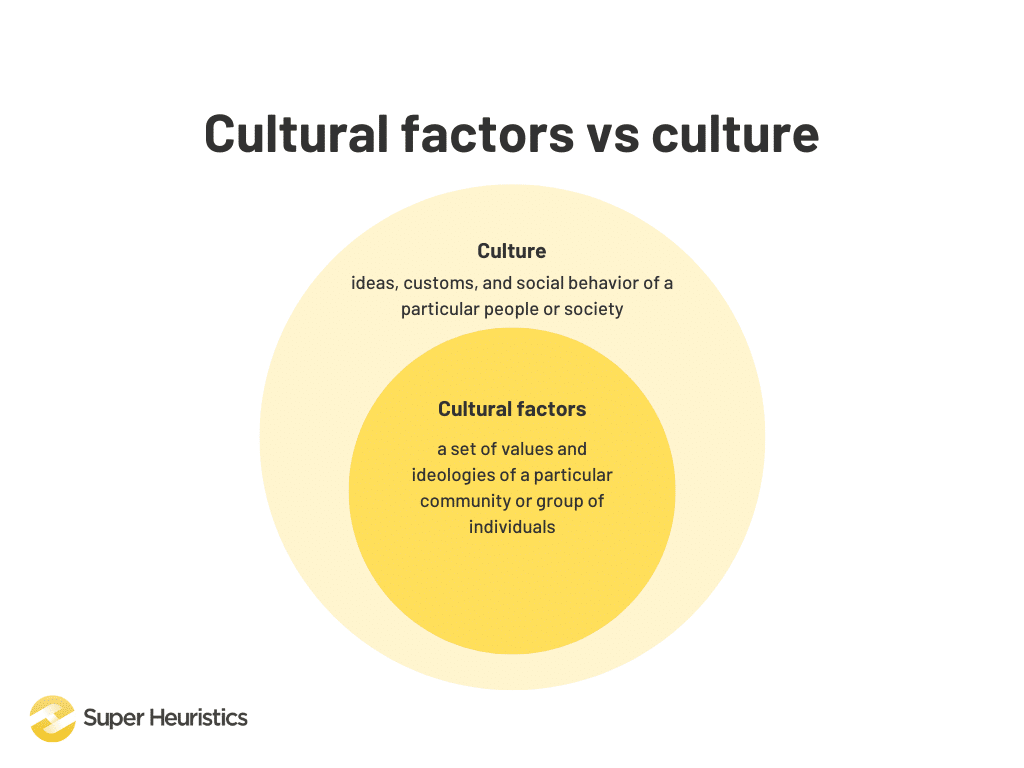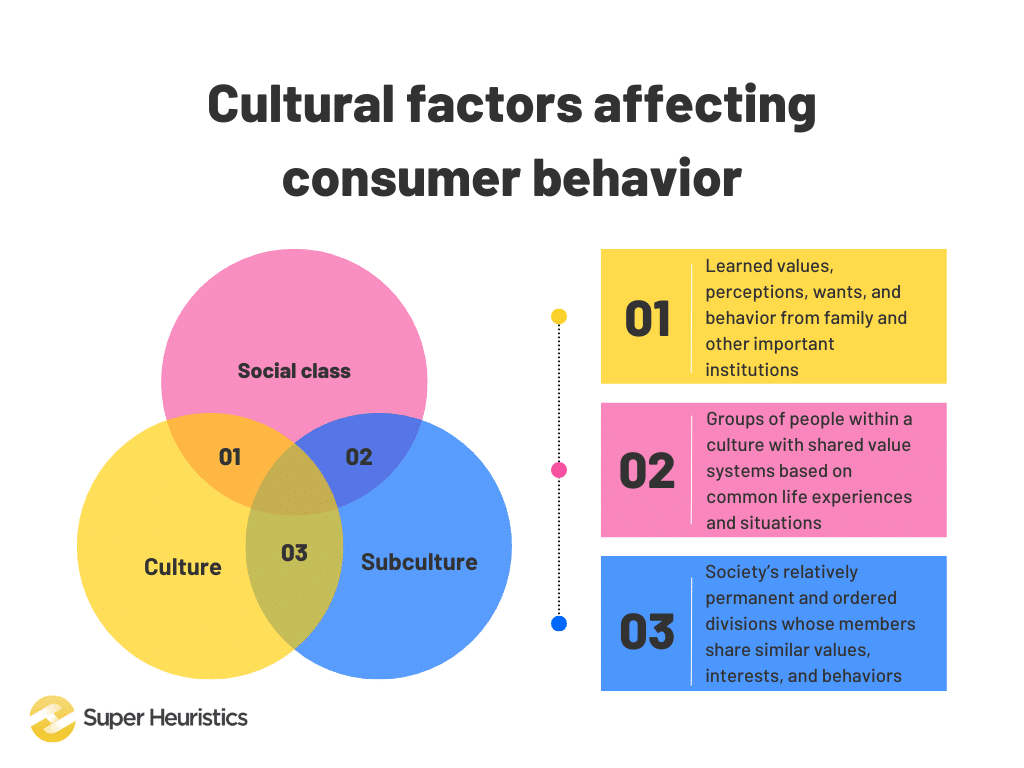Going forward with our timeless instant noodles examples, your favorite instant noodles brand will leave no stone unturned to appeal to its target market segment. One of the crucial factors a brand has to keep in mind while marketing its products is the target market’s cultural factors affecting consumer behavior.
It is in a brand’s best interest to try and prevent legal implications that arise out of an offensive marketing campaign. To avoid this complication, brands keep in mind the cultural factors affecting consumer behavior.
The culture of a region plays a huge role when companies plan marketing campaigns for them. For example, your favorite instant noodles brand might have beef and pork alternatives too, but it won’t advertise them as heavily as their vegetarian options in a diverse country like India.
But one thing that might pique your curiosity can be what is the relationship between consumer behavior and culture. What is the impact of culture on consumer behavior? In fact, what are the cultural factors that affect consumer behavior?
Let’s find out after understanding something much more important first.
How are cultural factors different from culture?
To understand what cultural factors are, we first need to understand what culture is.
The Oxford dictionary defines culture as “the ideas, customs, and social behavior of a particular people or society.”
In simpler terms, we can say that culture is what we learn from our parents, grandparents, and the society we live in.
Adding the word ‘factors’ to culture, we get cultural factors. These can be defined as “a set of values and ideologies of a particular community or group of individuals.” The terms culture and cultural factors are closely related, but cannot be used interchangeably.
Cultural factors can be said to comprise culture. While cultural factors can be studied more deeply for a specific culture, culture itself is a very subjective concept. If we pick one cultural factor, we can study it across a plethora of cultures and get widely different findings.

Let us take an example.
Imagine a sociologist studying the culture in the villages near the deserts of Rajasthan. They want to compare their findings with what another sociologist found out about the culture of the tribes in the jungles of Andhra Pradesh.
This sociologist cannot study the culture itself without deciding the key areas which they want to compare. To actually compare their findings and decipher the differences between the two cultures, they need to select the cultural factors they will base their research.
These cultural factors are what we need to study as marketers to understand the scope and impact of cultural factors affecting consumer behavior.
Understanding the cultural factors affecting consumer behavior
Your favorite instant noodles brand is clever enough to understand the importance of studying the cultural factors affecting consumer behavior. That is how it has avoided costly lawsuits all this time!
Many of the lawsuits against companies and brands are filed by consumers and non-consumers offended by their marketing campaigns. These lawsuits are expensive not only in terms of the money companies spend on legal proceedings but also on their marketing campaigns.
For example, the infamous lawsuit against Layer’s Shot perfume advertisement, in which four men enter a room where a couple is sitting on the bed. The four men then proceed to say some double-entendre sentences that appear to threaten the woman with gang rape. The men were apparently talking about the Shot perfume.
Although there are no reports available as of now, this whole ordeal is sure to have cost some huge bucks the irresponsible company. In an age where rape culture is at its peak, the slightest hints at even condoning it can cost a company its entire reputation.
To avoid these mistakes, the best way to go forward is to thoroughly research the three cultural factors that influence consumer buying behavior before giving the thumbs up to a marketing campaign or even to a product.

1. Culture
As defined earlier, culture is “the ideas, customs, and social behavior of a particular people or society.” These ideas, customs, and social behaviors are learned through observation and imitation. They are also taught directly by parents, grandparents, and other elders in society.
Another definition of culture by Phillip Kotler is
Culture is the learned values, perceptions, wants, and behavior from family and other important institutions.
There are certain buying behavior patterns that can be observed in consumers from a certain culture. These buying behaviors are passed down to children, whether consciously or unconsciously.
Cultures vary hugely from one region to another. It varies not only from country to country but also from state to state. Similarly, consumer behavior across these cultures also varies from region to region.
For example, your friend from Sikkim might prefer Wai Wai instant noodles, and your friend from Delhi is more likely to prefer Korean instant ramen brands or Maggi. This is not only because of the availability of different brands.
Your friend from Sikkim is most likely to be used to subtler flavors and tastes because of the food of the region. Wai Wai instant noodles have a subtler flavor and are soupier than Maggi, which might perfectly suit your friend’s taste because they must have grown up eating similar food and noodles.
On the other hand, your Delhiite friend might prefer Maggi because it tastes more like North Indian food. It is more ‘masaledaar’ and is more likely to suit their preferences, again due to the food they have grown up eating.
2. Subculture
The Oxford dictionary defines subculture as “a cultural group within a larger culture, often having beliefs or interests at variance with those of the larger culture.” In Phillip Kotler’s words,
Subcultures are groups of people within a culture with shared value systems based on common life experiences and situations.
To take an example, in India, we have many religious subcultures, including Hinduism, Sikhism, Islam, Christianity, and many more. Though there are a few overlaps in buying behavior due to similar cultural factors affecting consumer behavior, there are a lot of differences too.
Since each religion professes different rules and regulations for its followers, we can see a clear divide in certain areas of consumption. Hindus are forbidden to consume beef because cows are holy animals according to their religious texts, and Muslims are forbidden to consume pork because pigs are evil according to their holy scriptures.
Similarly, subcultures can be formed according to consumers’ age, ethnicity, gender, the status of marriage, etc. When observed properly, the different subcultures formed on each basis will have different buying behaviors.
For example, your parents are less likely to consume instant noodles as frequently as you. A research conducted in Korea found that men consume almost twice as many instant noodles per day on average than women.
3. Social class
Britannica defines social class as “a group of people within a society who possess the same socioeconomic status.” Social class is also called class in short. It is also one of the major cultural factors affecting consumer behavior. According to Kotler,
Social classes are society’s relatively permanent and ordered divisions whose members share similar values, interests, and behaviors, measured by a combination of occupation, income, education, wealth, and other variables.
Kotler gives the major social classes as:
- Upper class
- Middle class
- Working class
- Lower class
One directly observable distinction between the buying behaviors of different classes is that the upper class is more likely to purchase luxury goods that reflect their status, whereas the lower class is more likely to purchase basic necessities to satisfy their needs.
For example, someone in the upper class is more likely to buy the most expensive brand of Korean instant noodles, while someone in the lower class is more likely to buy a cheaper and more Indian instant noodles brand.
Along with the cultural factors affecting consumer behavior, one more factor is quite important while studying consumer behavior. That factor is perception.
Perception is “the way in which something is regarded, understood, or interpreted.”
Members of a culture, a subculture, or a social class are perceived by other members of society in a certain way. For example, Baniyas are perceived as being miserly, and Punjabis are perceived as being spendthrifts.
These perceptions also structure consumer behavior of people. For example, to shun their miserly image, your Baniya friend might volunteer to pay the bill at a lunch, while your Punjabi friend might clutch their wallet tighter.
Conclusion and key takeaways
In this chapter, we have seen the cultural factors affecting consumer behavior. To recall, here are some key takeaways:
1. Cultural factors can be said to comprise culture. While cultural factors can be studied more deeply for a specific culture, culture itself is a very subjective concept. If we pick one cultural factor, we can study it across a plethora of cultures and get widely different findings.
2. There are three cultural factors affecting consumer behavior:
- Culture
- Subculture
- Social class
3. Another important factor to keep in mind while studying consumer behavior is perception.
In the next chapter, we will take a look at the social factors affecting consumer behavior.

